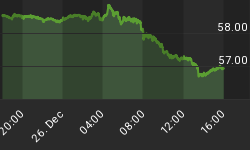Let's focus this week on the longer term forecast covering the next 7-8 years.
To do that, we'll have a look at an unusual but informative monthly DJIA chart, covering the whole history of the Dow, since its inception in 1896.

It is unusual because it shows the DJIA from the perspective of monthly mean reversion to a custom built yearly trend indicator. It is informative because it allows us to discover the hidden rhythm in over 116 years of DJIA history.
Looking at the index from this point of view, it is easy to see that there have been six stages (A to F) in Dow's history, lasting about 20 years each. Stages A and D are characterized by sharp, but more or less equal swings on both sides of the trend indicator, and represent periods during which the index finished mostly flat.
By contrast, stages C and E are periods during which the upswings were so strong and persistent that they overpowered the inevitable pullbacks, thus pulling the trend up.
Stage B is mixed in nature since it started with a sharp advance, but following the crash of '29 most of the gains were erased.
Currently, we seem to be in year 12 of another 20-year flat cycle ("F").
If we drill down further and compare all 28 bull runs during the last 115 years with respect to average daily percentage gain and duration, we come up with the following chart:

Although modestly powerful by historical standards, the current rally has outlasted all but 9 previous rallies. And of these 9 precedents, five were native to stages C and E.
Therefore, as this up cycle matures, investors should be asking themselves whether they feel lucky betting against 115 years of Dow history.
The above is an excerpt from my new seasonal Guide to trading the DJIA and SPX, where you will find a more detailed and complete analysis of what to expect for the remainder of this cycle.
















